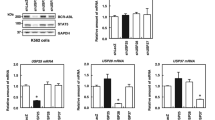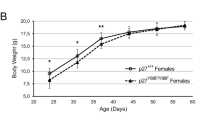Abstract
c-myb activation by insertional mutagenesis in murine myeloid leukemias can lead to amino (NH2)-terminal or carboxyl (COOH)-terminal truncation of its protein product. We observed that in these leukemias, the steady state level of the protein truncated at the COOH terminus was remarkably higher than that of the protein truncated at the NH2-terminus or full length wild-type protein. To examine the rate of proteolysis of different forms of Myb in a uniform cellular background, the proteins were constitutively expressed in the myeloblast cell line M1, using the retrovirus vector LXSN. In pulse chase experiments, using metabolically 35S-labeled proteins, it was determined that COOH-terminal truncation of c-Myb by 248 aa (CT-c-Myb) substantially increases protein stability, resulting in a t1/2 of about 140 min, as compared to 50 min for full length c-Myb (FL-c-Myb). In an investigation of the mechanism involved in the in vivo degradation of this short lived transcription factor, inhibitors of the lysosomal (chloroquine), proteasomal (ALLM, ALLN, lactacystin) and calpains (EGTA, E-64d, BAPTA/AM) pathways were utilized. Results of this experiment identified the 26S proteasome as a major pathway responsible for rapid breakdown of the protein in hematopoietic cells. Further experiments carried out in vitro demonstrated that c-Myb can be ubiquitinated, suggesting that this process may be involved in the targeting of wild-type c-Myb to degradation by the 26S proteasome. In addition, it was demonstrated that CT-c-Myb was less efficiently ubiquitinated than wild-type protein indicating that defects in modification account for its escape from rapid turnover. We speculate that the increased half-life of c-Myb resulting from truncation could contribute to its transforming potential.
This is a preview of subscription content, access via your institution
Access options
Subscribe to this journal
Receive 50 print issues and online access
$259.00 per year
only $5.18 per issue
Buy this article
- Purchase on Springer Link
- Instant access to full article PDF
Prices may be subject to local taxes which are calculated during checkout
Similar content being viewed by others
Author information
Authors and Affiliations
Rights and permissions
About this article
Cite this article
Bies, J., Wolff, L. Oncogenic activation of c-Myb by carboxyl-terminal truncation leads to decreased proteolysis by the ubiquitin-26S proteasome pathway. Oncogene 14, 203–212 (1997). https://doi.org/10.1038/sj.onc.1200828
Received:
Revised:
Accepted:
Issue Date:
DOI: https://doi.org/10.1038/sj.onc.1200828
Keywords
This article is cited by
-
Rational design of a helical peptide inhibitor targeting c-Myb–KIX interaction
Scientific Reports (2022)
-
Ordered structure induced in human c-Myc PEST region upon forming a disulphide bonded dimer
Journal of Chemical Sciences (2021)
-
DDR2 controls the epithelial-mesenchymal-transition-related gene expression via c-Myb acetylation upon matrix stiffening
Scientific Reports (2017)
-
Role and potential for therapeutic targeting of MYB in leukemia
Leukemia (2013)
-
Challenges in Vector and Trial Design Using Retroviral Vectors for Long-Term Gene Correction in Hematopoietic Stem Cell Gene Therapy
Molecular Therapy (2012)



